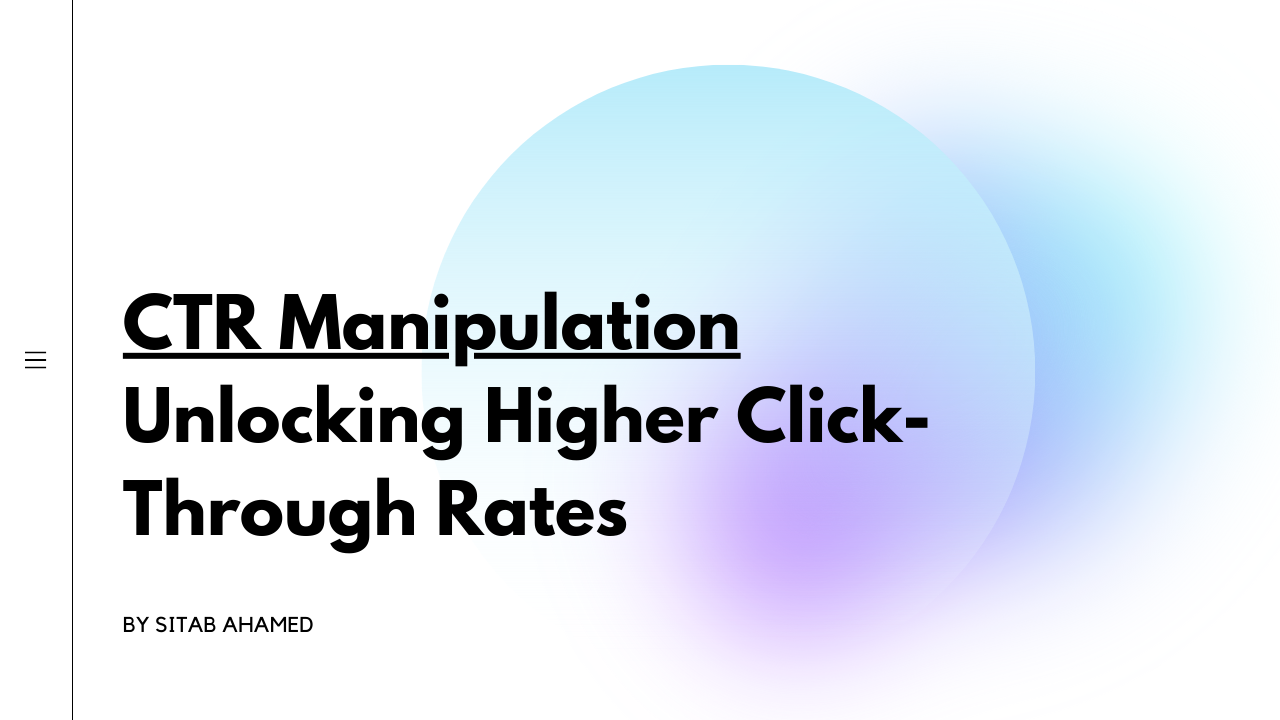LinkDaddy CTR Manipulation-- Proven Methods for Better Online Involvement
LinkDaddy CTR Manipulation-- Proven Methods for Better Online Involvement
Blog Article
CTR Manipulation: A Video Game Changer for Digital Projects
The rise of CTR control has undeniably changed digital advertising strategies, providing marketing professionals with tools to enhance involvement and drive web traffic effectively. What implications might this balancing act hold for the future of digital campaigns?
Understanding CTR Adjustment
Although click-through price (CTR) control may feel like a straightforward tactic in digital advertising, it incorporates a variety of techniques aimed at unnaturally pumping up involvement metrics. This control can take different kinds, including using click farms, robots, or misleading advertisement placements that misdirect consumers right into clicking. These strategies can compromise the integrity of performance information, making it testing for marketing professionals to gauge the genuine performance of their campaigns.
Furthermore, CTR adjustment elevates moral worries, as it undermines the openness of electronic advertising. The dependence on inflated metrics can cause misdirected marketing choices, skewing resource appropriation and campaign approaches. As a result, businesses might invest heavily in networks and tactics that appear successful however do not generate genuine interaction or conversions.

Advantages of Click-Through Rate Optimization
Optimizing click-through rate (CTR) is crucial for boosting the performance of electronic marketing projects. A greater CTR indicates that a bigger percentage of customers are engaging with the material, which can result in boosted web site web traffic and better conversion rates. By enhancing CTR, brands can properly allot their advertising and marketing sources to initiatives that produce the greatest returns.
Among the primary benefits of CTR optimization is the possibility for boosted advertisement positioning and reduced prices - CTR Manipulation. Systems like Google Ads compensate greater CTRs with much better ad positioning and lowered cost-per-click (CPC), allowing marketing experts to extend their budgets better. Furthermore, a well-optimized CTR can enhance brand name visibility, as higher involvement prices commonly correlate with enhanced organic reach

Methods for Efficient CTR Manipulation
To properly adjust click-through prices (CTR), marketing professionals can employ a variety of strategic techniques that boost individual engagement and drive web traffic. One fundamental method is enhancing advertisement copy to produce engaging and action-oriented language. CTR Manipulation. Making use of solid call-to-action (CTA) expressions motivates users to take instant action, enhancing the chance of clicks
An additional reliable strategy is A/B screening, which allows marketing experts to contrast different advertisement variants. By methodically assessing performance metrics, they can recognize which elements reverberate best with the target audience, thus fine-tuning their techniques for maximum effect. Furthermore, leveraging aesthetically appealing graphics and succinct messaging can catch interest quickly, making it a lot more likely that customers will certainly engage.

Lastly, maximizing landing pages to ensure a seamless user experience can minimize bounce rates and encourage more interaction, eventually fostering greater CTR. By incorporating these techniques, marketing professionals can efficiently adjust CTR to accomplish their campaign objectives.
Determining Success in Digital Projects
Gauging success in electronic projects calls for a clear understanding of essential efficiency signs (KPIs) that align with project purposes. KPIs work as quantifiable metrics that aid evaluate the efficiency of various why not look here strategies employed throughout the campaign. Typical KPIs include click-through prices (CTR), conversion rates, expense per acquisition (CPA), and roi (ROI)
To efficiently gauge success, it is important to establish particular, measurable objectives at the beginning of the project. For instance, if the main objective is to boost brand name awareness, metrics such as perceptions and interaction rates might be focused on. In contrast, projects concentrated on straight sales would gain from a much more comprehensive evaluation of conversion prices and profits generated.
Routine evaluation of these KPIs enables marketing professionals to make data-driven decisions, optimizing their techniques in real-time. Making use of analytical tools can help in tracking performance and determining trends, allowing for swift changes to improve campaign results. Inevitably, a thorough approach to gauging success not just highlights areas for improvement but also strengthens the general efficiency of electronic advertising initiatives, driving continual development and engagement in the long-term.
Future Trends in Digital Marketing
Anticipating the future of electronic advertising and marketing reveals a landscape shaped by fast technical developments and altering customer behaviors. As artificial knowledge and device discovering remain to advance, marketing professionals will progressively leverage these innovations to personalize campaigns at an extraordinary range. Predictive analytics will certainly enable brands to prepare for customer demands, enhancing ad positionings and material distribution in genuine time.
Furthermore, the increase of voice search and wise gadgets is changing how customers interact with digital web content. Marketing experts will require to adjust their methods to additional reading guarantee presence across several platforms, including voice-activated aides. This change requires an emphasis on pop over to these guys conversational advertising and marketing, highlighting involvement via dialogue as opposed to traditional promotional tactics.
Furthermore, personal privacy issues are prompting adjustments in information collection methods. Openness and honest data use will certainly end up being paramount, driving brands to promote depend on and commitment amongst customers. The ongoing evolution of social media systems will also affect marketing techniques, with a heightened focus on credibility and user-generated content.
Final Thought
In recap, CTR control represents a significant development in electronic advertising methods, offering prompt benefits via enhanced interaction metrics. Nonetheless, the ethical considerations surrounding such techniques require a cautious method to ensure lasting brand stability and real target market link. By striking a balance in between optimization strategies and authentic interaction, marketers can cultivate sustainable relationships with consumers. The continuous advancement of digital marketing will certainly depend upon this delicate interaction, shaping the future landscape of brand-consumer interactions.
Report this page